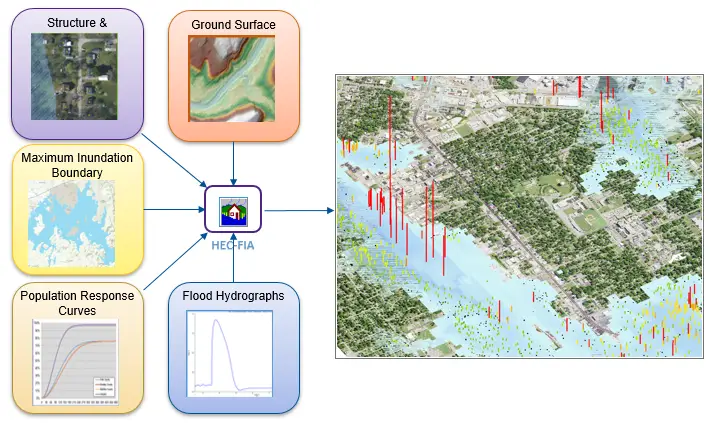A comprehensive update for a major regional network of dams and reservoirs
Objective
To support the Tennessee Valley Authority's practice of risk-informed decision making.
Approach
We equipped TVA with the latest software for analyzing flood hazards, hydraulic modeling and EAP Mapping, and assessing downstream consequences.
Impact
The TVA is able to operate more effectively and make decisions that protect public safety.
Since 2014, RTI has supported the Tennessee Valley Authority (TVA), a leader in implementing risk-informed decision making (RIDM), in developing models, datasets, and decision support tools for TVA’s dam safety program.
As an initial step, RTI worked with TVA to bring their hydrologic, reservoir, and hydraulic models into current software platforms that can efficiently generate results and outputs to be used in subsequent analysis. These updates were mainly completed under the Probable Flood Hazards Analysis, EAP Mapping Project, and Consequences Analysis.
Probable Flood Hazards Analysis
To determine the probability of flood loading at each dam in the TVA system, RTI has worked with TVA to build a system that calculates hydrologic hazard relationships for dams using the Stochastic Event Flood Model (SEFM) system. RTI’s teaming partners, MGS Engineering, MetStat, and Applied Climate Services, developed precipitation-frequency relationships for critical watersheds in the TVA system based on a regional frequency analysis. The precipitation-frequency relationships are used in combination with historical storm templates to generate feasible precipitation scenarios with stochastic sampling. A continuous long-term simulation is employed to generate a database of seasonally varying initial conditions (starting soil moisture, river and reservoir levels) that can be used to define starting conditions for each unique event simulation. Tens of thousands of combinations of storm depth, storm pattern, and initial conditions are drawn and run through a series of hydrologic and reservoir operations models to simulate the response of the system to extreme events. For each simulation, key statistics such as peak reservoir inflow, outflow, pool elevation or duration above critical thresholds are calculated. From this information, frequency curves (i.e., hydrologic hazard curves) can be generated for each variable.
The framework also allows for quantification of uncertainties associated with the resulting hydrologic hazard curves, sampling of gate reliability, and provides toolset to analyze and understand the scenarios and underlying simulations. This system is currently being used by TVA to quantify hydrologic loading for many of their dams to support their RIDM process.

Hydraulic Modeling and EAP Mapping
Starting in 2013, RTI developed a comprehensive hydraulic model (HEC-RAS) of the entire Tennessee Valley that included all dams and reservoirs. Detailed operational rules were included for each dam within HEC-RAS to allow the model to accurately route inflows through the system. This model was initially developed to support emergency action plan (EAP) development for all dams in their system but is now used to support the consequences modeling effort—a major component of TVA’s risk analyses. The HEC-RAS models support the risk analyses by performing flow routing and dam breach computations for consequence estimation.
Downstream Consequences Analysis
Since 2014, RTI has performed consequences assessments for over 20 TVA dams with ongoing efforts in continued support for consequence analysis. Initial consequences work was used to support construction decisions on Pickwick and Boone Dams. During this time, RTI developed a standard operating procedure for TVA that ensures consequences studies are performed to a consistent standard across the portfolio. Consequences results are an integral piece of the RIDM process and are used to quantify the damages for each of the flood and breach scenarios in the risk model.

Consequences assessments for TVA were originally performed using the US Army Corps of Engineers (USACE) Hydrologic Engineering Center Flood Impact Analysis (HEC-FIA) software. More recent analyses are being completed with the state-of-practice USACE HEC-LifeSim model. HEC-LifeSim estimates flood and breach consequences with uncertainty using improved evacuation simulation and fatality relationships. RTI has provided continued support to help TVA develop and update their standard operating procedures to correspond with the latest software releases.
The foundation of the consequences studies are the hydraulic results, which are produced using the USACE HEC-RAS hydraulic model. Hydraulic models include a range of breach and non-breach scenarios that correspond with the loading conditions developed in the hydrologic hazards analysis.
Once the hydraulic scenarios are successfully developed and executed, the HEC-FIA or LifeSim models are used to estimate life loss and economic consequences. These models estimate warning issuance, dissemination, and action based on emergency manager interview responses to simulate how the population may respond to a dam breach event with a defined warning system, then simulates the movement of individuals exiting the floodplain via available road networks. The LifeSim model incorporates uncertainty information in the life loss computations to provide a range of life loss estimates, recognizing the large uncertainties in behavior in the event of a dam breach. Outputs from this process are used in the RIDM process.

RTI continues to support TVA in several projects related to risk and decision-making, including hydrologic hazards assessments, hydraulic modeling, and consequences estimation. Our support ensures they have access to the latest software and methods to best inform operational and public safety-related decisions.
- Tennessee Valley Authority (TVA)


